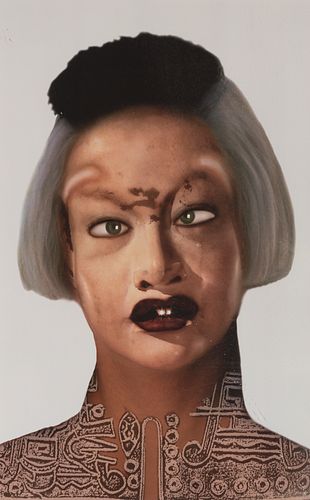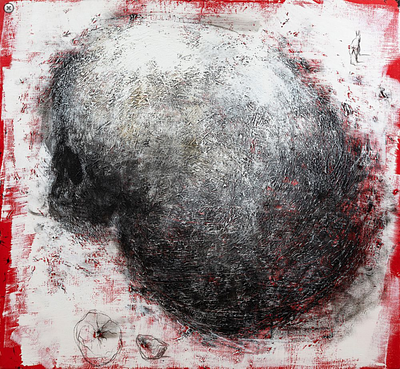ORLAN (Saint-Étienne, France, 1947). "Disfiguration-Refiguration, Precolumbian Self-Hybridization" No. 12, 1999. Photograph. Specimen 2/7.
Lot 50
About Seller
Setdart Auction House
Carrer Aragó 346
Barcelona
Spain
Setdart Subastas was born in 2004 and is currently the first online art auction in Spain with solidity, prestige and reliability guaranteed by our more than 60,000 users. Setdart has a young, dynamic and enterprising team ready to successfully manage the purchase and sale of art works through custom...Read more
Categories
Estimate:
EUR€2,000 - EUR€2,500
$2,061.86 - $2,577.32
Absentee vs Live bid
Two ways to bid:
- Leave a max absentee bid and the platform will bid on your behalf up to your maximum bid during the live auction.
- Bid live during the auction and your bids will be submitted real-time to the auctioneer.
Bid Increments
| Price | Bid Increment |
|---|---|
| EUR€0 | EUR€10 |
| EUR€200 | EUR€25 |
| EUR€500 | EUR€50 |
| EUR€1,000 | EUR€100 |
| EUR€3,000 | EUR€200 |
| EUR€5,000 | EUR€500 |
| EUR€10,000 | EUR€1,000 |
| EUR€20,000 | EUR€2,000 |
| EUR€50,000 | EUR€5,000 |
About Auction
By Setdart Auction House
Oct 19, 2021
Set Reminder
2021-10-19 08:00:00
2021-10-19 08:00:00
America/New_York
Bidsquare
Bidsquare : CONTEMPORARY ART
https://www.bidsquare.com/auctions/setdart-auction-house/contemporary-art-7701
Setdart Auction House sofia@setdart.com
Setdart Auction House sofia@setdart.com
- Lot Description
ORLAN (Saint-Étienne, France, 1947). "Disfiguration-Refiguration, Precolumbian Self-Hybridization" No. 12, 1999. Photograph. Specimen 2/7. Dampness and damage to the frame. Signed, justified, and titled on the back. Measurements: 100 x 100 cm; 104 x 104 cm (frame). In this photograph, Orlan continues to question the social and cultural pressures exerted on the body and its representation in the media. Orlan has created a new image in this work, literally combining pre-Columbian and African icons with his own image; the resulting hybridizations create a complex narrative that blurs distinctions between time and place, real and unreal. He has created a new image to produce new images: Self-Hybridizations. The work contains evidence of past tribal rites and rituals associated with beautification that, along with her own modifications through plastic surgery, argue over salient issues in recent history such as collective identity, tragedy and exclusivity. The self-hybridizations also act as portraits of a potential future humanity, in which interbreeding between humans of diverse origins gives rise to new bodies, with nomadic and mutant identities. ORLAN's career as a performance artist began in 1964, when he performed Marches au ralenti (slow-motion walks) in his hometown of Saint-Étienne. During these performances, he walked as slowly as possible between two central parts of the city. In 1965, ORLAN produced MesuRages, in which he used his own body as a measuring instrument. With his "ORLAN-body" as a unit of measurement, he assessed how many people could fit into a given architectural space. This was the first time he used his body in a performance piece. ORLAN reused this concept in several subsequent projects. Between 1964 and 1966, ORLAN produced Vintages, a series of black and white photographic works. She destroyed the original negatives of these pieces and today only one copy of each photograph remains. In this series, she posed nude in various yoga-like positions. One of the most famous images from this series is ORLAN accouche d'elle m'aime.Between 1967 and 1975, ORLAN produced a body of work entitled Tableaux Vivants. He based them on the works of Baroque artists such as El Greco and Gericault. He used inmates as models, wore exaggerated imitation Baroque costumes and drew inspiration from Caravaggesque stereotypes. In 1971, ORLAN "christened itself" Sainte-ORLAN, adorning itself in black corrugated vinyl and white faux leather. Color photographs of Sainte-ORLAN were subsequently incorporated into photo-collages, videos and films tracing a fictional hagiography. During the 1977 FIAC International Contemporary Art Fair in Paris, ORLAN performed the controversial performance piece The Artist's Kiss (Le baiser de l'artiste). Outside the Grand Palais in Paris, a life-size photo of his torso was turned into a slot machine. Spectators could watch the coin inserted into the torso descend into a groin before receiving a kiss from the artist.ORLAN founded the International Performance Symposium in Lyon. In 1982, he collaborated with artist Frédéric Develay to create the first online contemporary art magazine, Art-Accès-Revue, on the French precursor to the Internet, the Minitel. In 1990, ORLAN initiated the Reincarnation of Sainte-ORLAN. This is a series of plastic surgeries through which the artist transformed herself into elements of famous paintings and sculptures of women. As part of her manifesto "Carnal Art", these works were filmed and shown in institutions around the world, such as the Georges Pompidou Center in Paris and the Sandra Gehring Gallery in New York. ORLAN's goal in these surgeries is to acquire the ideal of feminine beauty as depicted by male artists.
- Shipping Info
-
In-house shipping available. Please inquire at admin@setdart.com.
-
- Buyer's Premium



 EUR
EUR CAD
CAD AUD
AUD GBP
GBP MXN
MXN HKD
HKD CNY
CNY MYR
MYR SEK
SEK SGD
SGD CHF
CHF THB
THB















